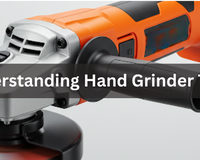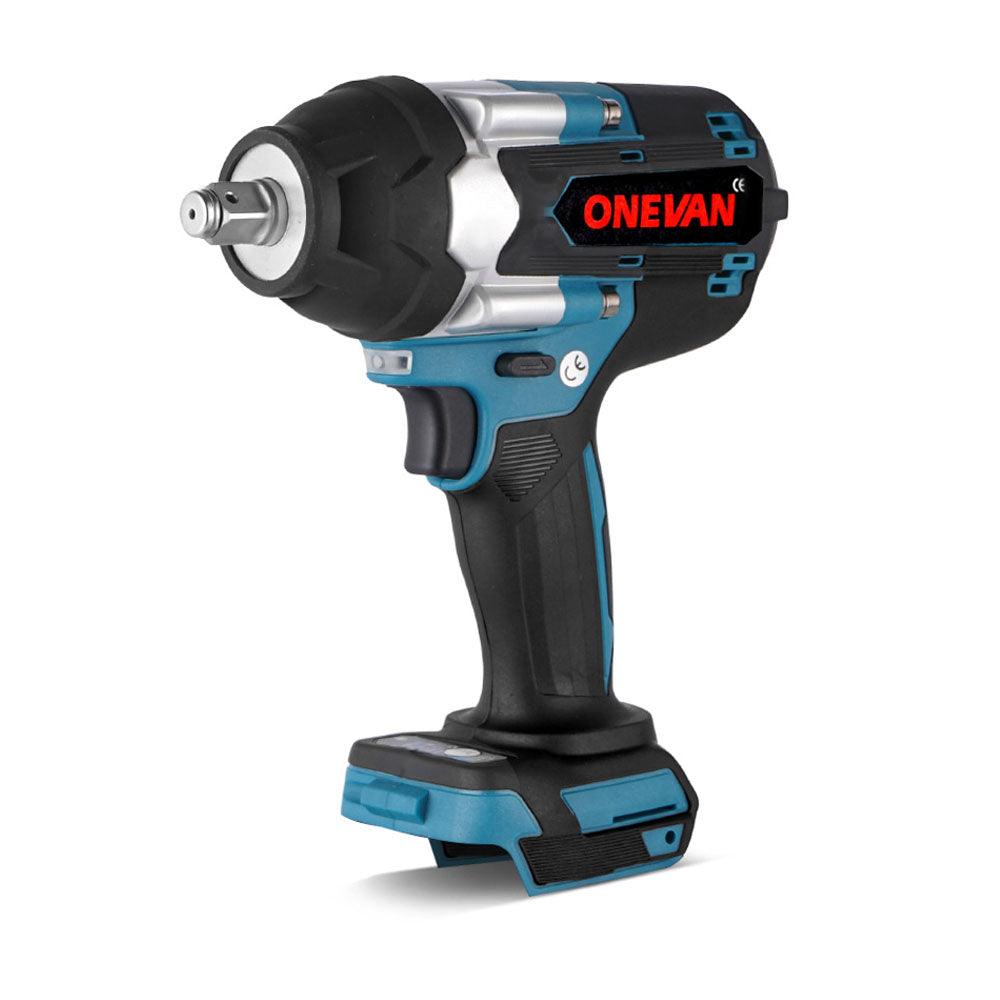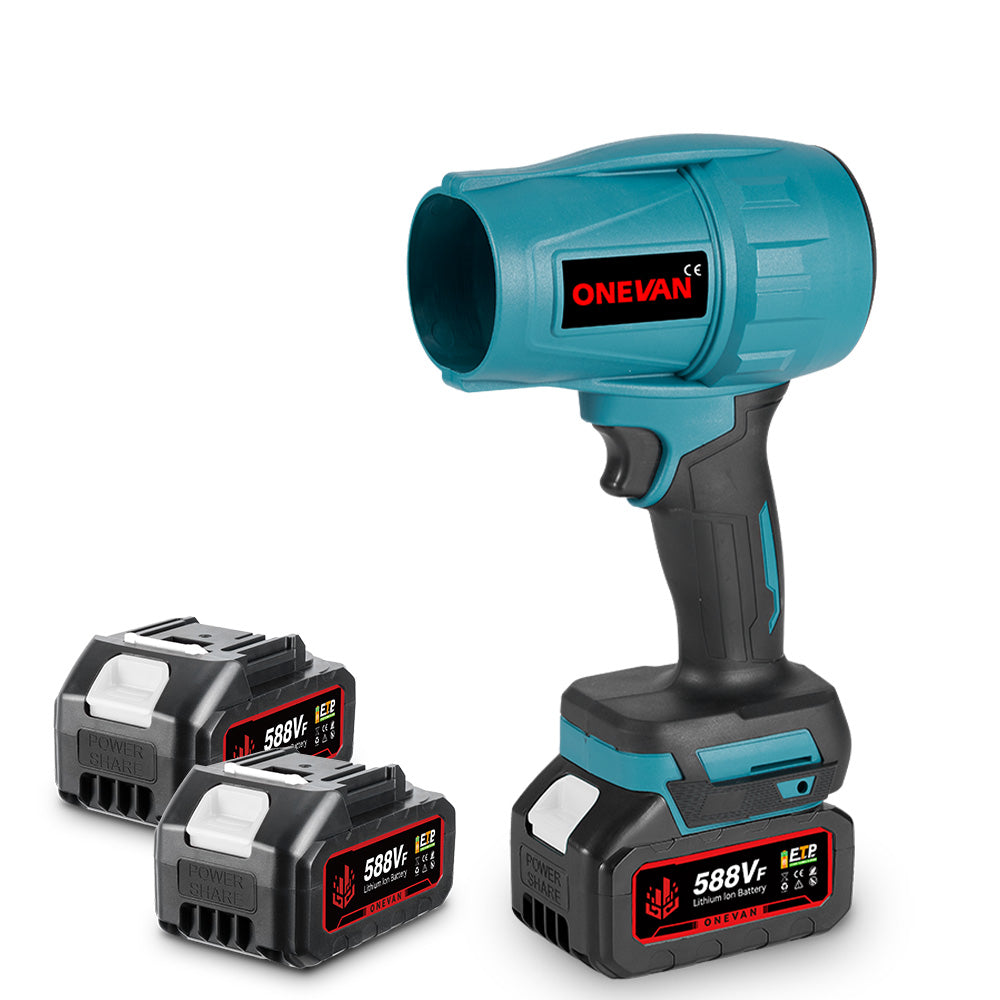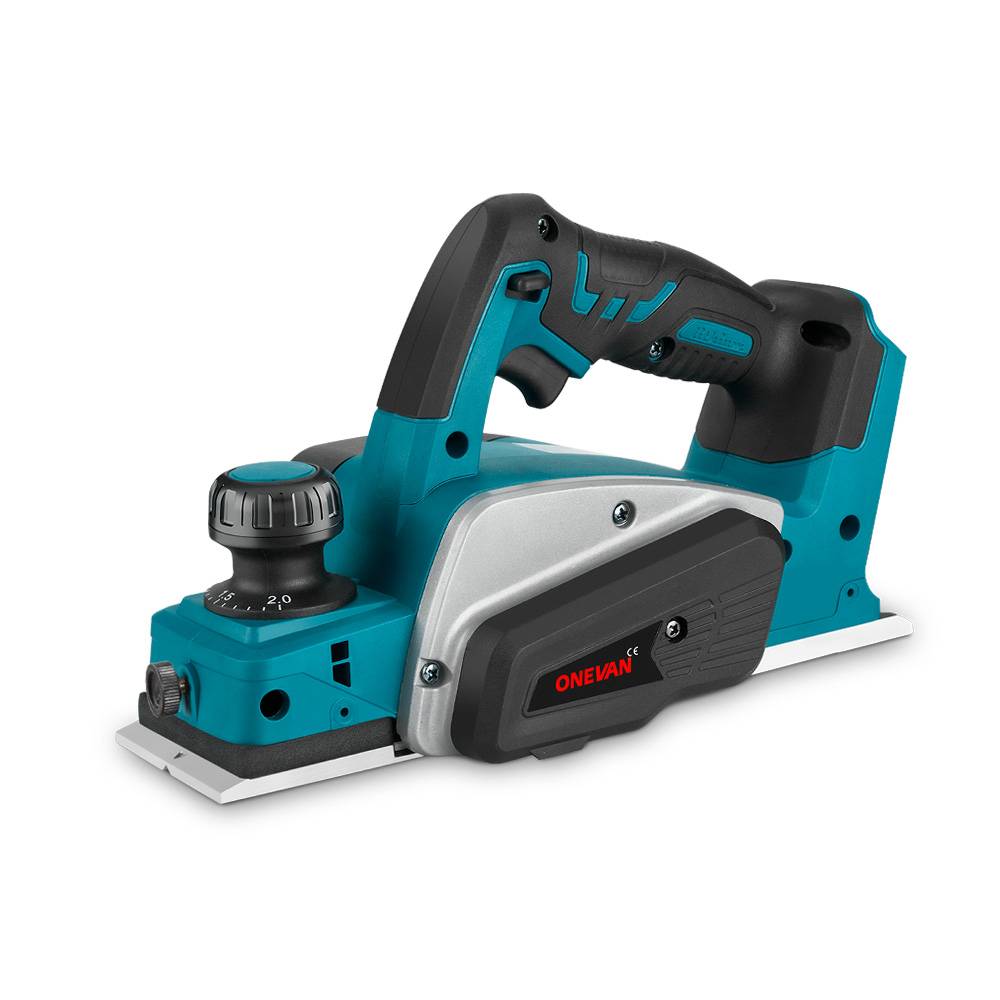La vieja rutina de soplar hojas es bastante frustrante y consume mucho tiempo. ¿Cansado de los métodos de limpieza tradicionales? Es hora de conseguir un soplador inalámbrico que supere tus expectativas. Los sopladores de batería son herramientas eléctricas modernas, ligeras y compactas. Se pueden usar en una amplia gama de aplicaciones, más allá de la limpieza de hojas secas.
Por eso, en el artículo de hoy abordaremos temas apasionantes, como por ejemplo, cómo utilizar sopladores inalámbricos para proyectos de bricolaje.
1. Beneficios de usar un soplador inalámbrico para proyectos de bricolaje
Los sopladores de hojas inalámbricos , también conocidos como sopladores de batería, ofrecen numerosas ventajas al ser herramientas eléctricas que funcionan con batería .
Portátil
Llevar el soplador inalámbrico a todas partes es muy práctico, ya que puede llevarlo a cualquier parte. Esto significa que su diseño no tiene cable, lo que puede causar tropiezos o restringir el movimiento. Ya sea que esté soplando las hojas caídas en el recinto o el polvo en el patio, nunca tendrá que preocuparse por dónde enchufarlo ni dónde se enredarán los cables. ¡La comodidad es lo importante!
Compacto y fácil de controlar
Generalmente, los sopladores inalámbricos están diseñados para ser ligeros, lo que los hace fáciles de manejar. No es como cargar con un equipo voluminoso y difícil de manejar. Además, la mayoría de sus diseños son ergonómicos, lo que le permite sujetarlos sin esfuerzo y terminar su trabajo sin cansarse. Si barre los escombros o simplemente quiere limpiar su habitación rápidamente, los encontrará fáciles de manejar.
Configuraciones de potencia ajustables
Muchos sopladores inalámbricos también cuentan con otra práctica función: la regulación de potencia. Esto significa que puedes obtener el flujo de aire exacto que necesitas según la tarea que estés realizando. Supongamos que solo usas el aspirador para quitar el polvo de los muebles del patio. En ese caso, puedes usar la configuración baja para ahorrar batería. Sin embargo, si estás lidiando con un montón de hojas, puedes usar la potencia máxima. Esa es su ventaja: la flexibilidad que ofrece, ¡a la altura de tus necesidades!
Ecológico
Supongamos que tiene conciencia ambiental. En ese caso, le convendrán los sopladores inalámbricos, ya que son herramientas eléctricas ecológicas. Funcionan con baterías recargables, por lo que no producen gases ni emisiones peligrosas. Esto significa que puede limpiar su patio o su lugar de trabajo sin contribuir a la contaminación del aire. Además, la mayoría de los modelos incluyen funciones de ahorro de energía, lo que los hace eficientes.
2. Proyecto de bricolaje n.º 1: Soplador inalámbrico para secar pintura

Si te apasiona pintar, comprenderás lo mucho que lleva esperar a que la pintura se seque; es como esperar a que crezca la hierba. Pero con un soplador inalámbrico, ¡puedes hacerlo mucho más rápido! Ahora, veamos cómo esta versátil herramienta puede ayudarte a secar tus objetos pintados lo antes posible.
Materiales necesarios
- soplador inalámbrico
- Tendedero o ganchos
- Accesorio de ventilador pequeño (opcional)
Instrucciones paso a paso
Paso 1: Configuración de su espacio de trabajo
Este es el lugar donde colocarás los objetos que planeas pintar. ¡Debe haber una buena circulación de aire!
Paso 2 : ¡A pintar!
Una vez preparado el espacio de trabajo, puede pintar como de costumbre. Una vez terminado, tome su soplador inalámbrico. Para mayor seguridad, comience a usar el soplador a baja potencia. Estas corrientes de aire ayudarán a acelerar el secado de los elementos pintados sin dañar la pintura.
Paso 3 : Distanciarse
Al usar un soplador de hojas a batería , tenga cuidado de no acercarlo demasiado a los objetos pintados. Para evitar tocar la pintura húmeda, mantenga una distancia segura entre su cara y la pintura, de unos 30 a 45 cm. De esta manera, aprovechará el flujo de aire sin salpicar ni manchar las superficies cercanas al ventilador.
Paso 4: Utilice un accesorio de ventilador para proyectos más grandes
Si está trabajando en algo grande, como un mueble, debería usar el ventilador pequeño, si lo tiene. Esto ayuda a distribuir el aire correctamente y garantiza que todas las piezas de su proyecto se sequen correctamente. ¡Ayuda a trabajar con eficacia en áreas grandes!
Beneficios del proyecto
Para secar pintura, no hay mejor herramienta que un soplador inalámbrico. Reduce el tiempo de secado, lo cual es muy beneficioso, especialmente al trabajar en manualidades grandes o pintar muebles. Esto ahorra tiempo y permite pasar a la siguiente etapa del proyecto lo antes posible, haciendo que el bricolaje sea más eficiente y divertido.
3. Proyecto de bricolaje n.º 2: Soplador inalámbrico para crear iniciadores de fuego al aire libre
Encender una fogata no siempre es fácil, especialmente si la quieres para un evento en el jardín o una acampada. Sin embargo, ¡un soplador inalámbrico te facilitará encenderla! Veamos cómo usar esta ingeniosa herramienta para hacer excelentes iniciadores de fuego para tu campamento al aire libre.
Materiales necesarios
- Ramitas pequeñas, hojas secas y astillas de madera.
- Papel o hierba seca
- soplador inalámbrico
Instrucciones paso a paso
Paso 1 : Recolección de su material de encendido
El primer paso es reunir la leña. Busca ramas pequeñas, hojas secas y trozos de madera. Estos arderán bien y te ayudarán a encender los troncos grandes. También necesitarás papel o hierba seca, que servirá como primera leña para tu fogata.
Paso 2: Preparación del fogón
Apila la leña en una pequeña pila en tu fogón o donde quieras encender el fuego. Arruga el papel o la hierba seca y colócala en la base de las ramitas y las virutas de madera. Ahora, toma tu soplador inalámbrico. Empieza con la potencia baja. Esto te permitirá soplar poco aire sobre la leña y no volarla por completo.
Paso 3: Encender el fuego
Finalmente, llega la parte más divertida. Sopla suavemente el papel y la leña con el soplador para crear un chorro de aire. Esto ayudará a avivar las llamas y a hacer que el fuego crezca. Observa cómo el fuego empieza a crecer por sí solo. Una vez que el fuego esté encendido y veas las llamas danzar, es hora de apagar el soplador. ¡Deja que el fuego arda como quiera!
Beneficios del proyecto
El encendedor con soplador de hojas a batería es rápido e increíblemente eficiente. Esto facilita mucho su uso para encender la fogata de su jardín o una fogata, especialmente cuando las condiciones no son las ideales. Con el combustible en gel, no perderá tanto tiempo intentando encender el fuego; en cambio, podrá dedicarle más tiempo, lo que le brindará calidez y belleza.
4. Proyecto de bricolaje n.º 3: Soplador inalámbrico para inflar decoraciones de exterior y juguetes de piscina
Llegó el verano, ¡y es hora de inflar esas decoraciones inflables de exterior y los juguetes de piscina! Por ejemplo, en lugar de usar una bomba manual, ¿por qué no usar un soplador inalámbrico, que es más eficiente? Es rápido, sencillo y te ahorrará mucho trabajo. Te explico cómo hacerlo paso a paso.
Materiales necesarios
- Soplador inalámbrico con boquilla infladora
- Decoraciones inflables o juguetes de piscina.
Instrucciones paso a paso
Paso 1: El primer paso para inflar cualquier artículo es conectar la boquilla del inflador.
Empieza por coger tu soplador inalámbrico y colocarle la boquilla infladora. Este pequeño aparato marca la diferencia, ya que dirige el aire como se desee. Asegúrate de que esté bien ajustado para que el aire no se escape fácilmente al inflar.
Paso 2: Coloque la boquilla en la válvula
Después, usa la boquilla, ábrela y fíjala a la válvula del artículo inflable que quieras inflar. Por ejemplo, una pelota de playa gigante o una decoración de jardín deben estar bien ancladas para evitar que se escape el aire.
Paso 3: Encender
¡Ahora es hora de animar la diversión! Ajusta la potencia del soplador a media. En poco tiempo, verás cómo tu artículo inflable empieza a formarse. Observa cómo sube. Cuando alcance el nivel deseado, puedes apagar el soplador y retirar la boquilla.
Beneficios del proyecto
Un soplador inalámbrico es ideal para inflar decoraciones y juguetes de piscina, lo que facilita enormemente el proceso. Es mucho más sencillo que inflarlo todo manualmente y ahorra tiempo y esfuerzo. Además, no tendrá que preocuparse por el dolor de brazos ni la falta de aire al inflar objetos grandes.
5. Proyecto de bricolaje n.° 4: Soplador inalámbrico para construir un aerógrafo casero para pintar
Si alguna vez has pensado en probar la aerografía, pero no quieres gastar cientos de dólares en equipo, te espera una gran oportunidad. Un soplador inalámbrico es una herramienta eficaz para crear un aerógrafo casero que funcionará como una herramienta profesional sin gastar mucho dinero.
Materiales necesarios
- soplador inalámbrico
- Kit de aerógrafo
- Pintura o barniz
Instrucciones paso a paso
Paso 1: Conecte el kit de aerógrafo al soplador.
Primero, conecta el kit de aerógrafo al soplador inalámbrico. Asegúrate de que la boquilla esté bien colocada para no perder presión al pintar. Una buena conexión es crucial para conseguir el acabado perfecto que siempre has deseado con el pulverizador.
Paso 2: Cargue el aerógrafo con pintura
El siguiente paso es aplicar pintura o barniz a la cámara del aerógrafo, lista para usar en el siguiente paso del proceso. Consulta las instrucciones del fabricante para saber cómo llenar el kit del aerógrafo y evitar errores. Selecciona tus colores favoritos y ¡comencemos a ver qué efectos quieres lograr!
Paso 3: Use el soplador a baja potencia para rociar pintura.
¡Por fin, llega la parte emocionante! Con el soplador encendido, ¿podrías ponerlo en la configuración más baja? Así tendrás más control sobre la pintura al aplicarla. Colócate a unos centímetros de la superficie y rocía con el aerógrafo. Desliza la boquilla con movimientos suaves y uniformes mientras aplicas el material para que las líneas queden impecables. Si necesitas ajustar el flujo, puedes modificar la configuración según sea necesario.
Beneficios del proyecto
Por ejemplo, usar un soplador inalámbrico para crear tu aerógrafo es económico y la forma perfecta de expresarte. Es posible lograr una apariencia elegante y limpia en pequeños objetos, ideales para manualidades, muebles o incluso arte. Además, es una actividad muy entretenida que te permitirá probar diversas técnicas y colores a un precio accesible en comparación con muchos sistemas de aerógrafo profesionales.
6. Proyecto DIY n.° 5: Soplador inalámbrico para cortador de espuma casero para manualidades
Si te gusta hacer manualidades, sabes que cortar espuma o poliestireno puede ser bastante complicado. Sin embargo, con un soplador inalámbrico, puedes cortar espuma fácilmente con un control razonable, lo que te permite moldear los materiales al tamaño deseado. En la siguiente sección, exploraremos cómo implementar esta herramienta inteligente en tu próximo proyecto.
Materiales necesarios
- soplador inalámbrico
- Boquilla calentada
- Bloques de espuma o poliestireno
Instrucciones paso a paso
Paso 1: Coloque la boquilla calentada
Primero, conecta la boquilla calefactora a tu soplador inalámbrico. Si no tienes una boquilla calefactora prefabricada, puedes fabricar una a medida que resista bien el calor. Asegúrate de que esté bien fijada para que no tengas que preocuparte por si se sale cada vez que cortes.
Paso 2: Para cortar la espuma, se calienta en las formas y tamaños requeridos antes de cortarla.
¡Ahora es el momento de ponerse manos a la obra! Enciende el soplador y ajústalo a potencia media o alta según el tipo de espuma que vayas a colocar en la cavidad. Acerca la boquilla caliente a la espuma para calentarla. Esto facilitará el corte a medida que se aplica el calor y se calienta. También es recomendable deslizar la boquilla suavemente sobre las líneas a cortar para que el calor haga la mayor parte del trabajo. Dibujar formas geométricas perfectas con una línea limpia y bien definida también será fácil.
Beneficios del proyecto
Un soplador inalámbrico también puede usarse como cortador de espuma en casa, ya que es más controlado y eficiente que el cortador de alambre caliente. En diversas manualidades, puede moldear espuma fácilmente sin que el alambre se enrede ni se produzcan cortes irregulares. Además, este método es más flexible; puede cambiar el patrón de corte para adaptarse a sus diseños deseados.
7. Proyecto de bricolaje n.° 6: Soplador inalámbrico para limpiar y quitar el polvo en zonas de difícil acceso

Siempre es muy difícil limpiar esos lugares difíciles de alcanzar dentro y fuera de una casa. Sin embargo, si se usa un soplador inalámbrico, ¡el trabajo se vuelve relativamente más sencillo y mucho más efectivo! Veamos cómo limpiar eficazmente el polvo y los residuos con esta herramienta tan útil.
Materiales necesarios
- Soplador inalámbrico con boquilla estrecha
Instrucciones paso a paso
Paso 1: Quitar el polvo
Primero, toma un soplador inalámbrico y conecta la boquilla estrecha. Este accesorio te ayudará a acceder a espacios reducidos, como detrás de muebles, aparatos electrónicos y las esquinas de las estanterías. Enciende el soplador a baja potencia y dirígelo hacia donde quieras eliminar el polvo y los residuos. Te sorprenderá lo fácil que es eliminar la suciedad de estas zonas.
Paso 2: Debes completarlo con un paño para quitar el polvo.
Una vez que el polvo se asiente, se recomienda usar un paño para limpiarlo mejor. Use una toallita húmeda para limpiar las superficies y asegurarse de eliminar cualquier resto de polvo que no haya podido eliminar el soplador. El toque final le dará a su espacio un aspecto limpio y fresco, como nuevo.
Beneficios del proyecto
Si usa un soplador inalámbrico, limpiar y quitar el polvo de zonas de difícil acceso será más fácil y rápido. No tendrá que agacharse para llegar a zonas difíciles ni aplicar fuerza para eliminar manchas difíciles sin dañar sus pertenencias. Además, no tendrá que trabajar en esta zona, ya que tendrá una casa limpia sin mucho esfuerzo.
8. Proyecto de bricolaje n.° 7: Soplador inalámbrico para construir un aerodeslizador casero
¿Quieres participar en un proyecto que no solo sea divertido, sino que también incorpore un poco de ciencia? Esto es genial si quieres construir algo con tus propias manos y divertirte, además de aprender algo de física: construir un aerodeslizador con un soplador inalámbrico. Bien, déjame empezar con este gran proyecto.
Materiales necesarios
- soplador inalámbrico
- Lámina de madera contrachapada o plástico
- Lámina de plástico para la falda.
- Adhesivo y cinta
Instrucciones paso a paso
El paso 1 implica desarrollar la base para un concepto más amplio y planificar cómo se implementarán los pasos subsiguientes.
Primero, toma la madera contrachapada o cualquier lámina de plástico donde quieras hacer la base del aerodeslizador y córtala al tamaño necesario. Con la base lista, toma la lámina de plástico para el faldón y únela a los lados de la base con adhesivo y cinta adhesiva. Asegúrate de que el faldón esté bien fijado para contener el aire a través del aerodeslizador.
Paso 2: Hay que cortar un agujero en la cabeza de la calabaza para el soplador.
En segundo lugar, debes hacer un orificio en el centro de la base para colocar la boquilla del soplador inalámbrico. Este orificio permitirá que el aire expulsado por el soplador escape y proporcionará la amortiguación necesaria para que el aerodeslizador se desplace sobre el suelo.
Paso 3: Instale el soplador
Finalmente, aceleremos el paso y pongamos en práctica la medida decisiva. Inserta el soplador en el agujero que has creado y asegúrate de que encaje correctamente. Una vez hecho esto, enciende el soplador. En este contexto, un aerodeslizador casero es más probable que flote sobre el suelo, no sobre la superficie del mar. Al golpearlo ligeramente, verás que se deslizará sobre la superficie del agua como un yate.
Beneficios del proyecto
Con un aerodeslizador, te divertirás, te divertirás y construirás de forma creativa, participando en un proyecto económico, ideal para niños y adultos. Es una excelente oportunidad para profundizar en principios de física como la presión y la flotabilidad. Además, es la oportunidad perfecta para animar a los niños a usar su imaginación y disfrutar de momentos emocionantes juntos.
9. Proyecto de bricolaje n.° 8: Soplador inalámbrico para secar espacios húmedos o alfombras

A veces ocurren accidentes y las alfombras y pisos pueden inundarse, lo cual puede ser un gran problema. ¡Pero no se preocupe! Probablemente nunca haya pensado que un soplador inalámbrico es una herramienta práctica para secar áreas húmedas de forma rápida y eficiente. Veamos los pasos a seguir para solucionar este problema y proteger su casa del moho y los daños causados por el agua.
Materiales necesarios
- soplador inalámbrico
- Toallas o almohadillas de secado (opcional):
Instrucciones paso a paso
Paso 1 : Limpiar con una toalla de papel
Cuando esté listo para usar el secador, es recomendable tener toallas o almohadillas de secado a mano. Úselas para absorber la mayor cantidad de agua posible de la zona húmeda. Esto ayudará a secar la ropa más rápido y permitirá que el secador funcione mejor. Solo tiene que presionar para absorber la mayor cantidad de tinta posible.
Paso 2: Seque el área con el soplador
¡Ahora, encienda su soplador inalámbrico! Colóquelo a una altura media y sople el aire hacia la parte húmeda de la habitación. Continúe soplando mientras mueve el soplador de un lado a otro para asegurar que el aire llegue a toda la alfombra o superficie. El flujo de aire ayudará a evaporar la humedad restante y, además, reducirá el tiempo de secado.
Beneficios del proyecto
En este caso, un soplador inalámbrico resulta de gran ayuda, ya que seca rápidamente las zonas húmedas. Reduce considerablemente el tiempo de secado de la alfombra y otras zonas de la casa, eliminando así el riesgo de daños por agua y la formación de moho. Esto es especialmente importante en zonas húmedas o después de un derrame, ya que es probable que se desarrolle moho con el tiempo si no se limpia la humedad.
10. Proyecto DIY n.° 9: Soplador inalámbrico para alimentar un mini túnel de viento casero para experimentos
Construir un túnel de viento en miniatura es un excelente proyecto escolar, atractivo y educativo. ¡Es una excelente manera de aprender sobre aerodinámica! Con un soplador inalámbrico, puedes hacer un montaje muy básico. ¡Comencemos!
Materiales necesarios
- Soplador inalámbrico: su principal fuente de flujo de aire para el túnel de viento.
- Tubos de plástico transparente o plexiglás: esto formará la estructura de su túnel de viento.
- Objetos de prueba ligeros:
Instrucciones paso a paso
Paso 1: Construcción del túnel de viento
Primero, cree un pequeño túnel de viento con tubos de plástico transparente o plexiglás, como se mencionó anteriormente. Puede construir un túnel recto con el ancho suficiente para que los objetos de prueba puedan pasar sin mayor dificultad. Asegúrese de dejar los extremos abiertos para que el aire fresco entre fácilmente en el sistema y el aire viciado pueda expulsarse fácilmente.
Paso 2: Configuración del soplador
Cuando el túnel esté listo, coloca el soplador inalámbrico en un extremo. Esto ayudará a crear el flujo de aire necesario para tus experimentos. Enciéndelo y deberías oír el viento soplando a través del túnel.
Paso 3: Experimentación con objetos de prueba
¡Aquí viene la parte divertida! Coloca tu equipo de prueba ligero a la entrada del túnel de viento y observa cómo reacciona al flujo de aire. Por ejemplo, enciende el soplador y muévelo alrededor de algunos objetos. Luego, intenta reducir la velocidad y observa cómo se mueven los objetos. ¡Es un buen momento para introducir términos como sustentación, resistencia y aerodinámica!
Beneficios del proyecto
Es muy divertido crear tu propio mini túnel de viento y una gran experiencia de aprendizaje. Ayuda a los niños a experimentar un aspecto de la aerodinámica desde la comodidad de sus hogares, haciendo que la ciencia sea divertida. Permite enseñar y aprender cómo diversos factores, como la forma, el peso y el flujo de aire, influyen en el aprendizaje.
11. Proyecto de bricolaje n.° 10: Soplador inalámbrico para limpiar rápidamente las herramientas del taller
Es muy importante limpiar las herramientas de su taller para garantizar su óptimo rendimiento y larga duración. No hay nada como un soplador inalámbrico para eliminar fácilmente el aserrín y los residuos sin dañar sus herramientas. ¡Veamos cómo usar esta práctica herramienta para mantenerlas limpias!
Materiales necesarios
- soplador inalámbrico
Instrucciones paso a paso
En el primer paso, limpiarás el aserrín y los escombros del piso del taller.
Paso 1: Use el soplador para limpiar el aserrín y los residuos de las herramientas
Úselo para eliminar el polvo, las virutas o las virutas que se hayan acumulado en las herramientas debido al uso o al procesamiento de la madera. Solo tiene que dirigir el soplador hacia la herramienta y dejar que la corriente de aire la limpie. Es rápido y eficaz, ¡y nunca deja suciedad!
Paso 2: Áreas de la casa con acumulación de polvo
Al limpiar, concéntrese en las áreas que suelen acumular polvo, como el interruptor cercano, las manijas y cualquier espacio oculto. Estas áreas suelen acumular suciedad, lo que puede causar desgaste a largo plazo. Mantener estas áreas limpias contribuirá a la funcionalidad de las herramientas y aumentará su durabilidad.
Beneficios del proyecto
A continuación, se presentan algunos beneficios que probablemente obtendrá al usar el soplador inalámbrico para limpiar las herramientas de su taller. La limpieza ayuda a mantener sus herramientas en buen estado, ya que la acumulación de polvo puede deteriorarlas. La limpieza no solo beneficia el funcionamiento de sus herramientas, sino también la seguridad y el dinamismo de su lugar de trabajo.
12. Proyecto de bricolaje n.° 11: Soplador inalámbrico para construir una barredora de césped sencilla
Si estás cansado de rastrillar hojas y buscas una forma más eficiente de limpiar tu jardín, sigue este tutorial para construir una barredora de césped sencilla con un soplador inalámbrico. Este proyecto casero te permitirá recoger las hojas caídas y los escombros sin mayor dificultad. Ahora, veamos los pasos para construir tu barredora de césped.
Materiales necesarios
- soplador inalámbrico
- Bolsa de basura o bolsa recolectora de polvo
- Marco o carrito pequeño
Instrucciones paso a paso
Paso 1 : Coloque una bolsa de basura en la parte trasera del carrito.
Comience colocando una bolsa de basura vacía o una bolsa recolectora de polvo en la parte trasera de su cuadro o carrito pequeño. Asegúrese de que esté bien sujeta para que recoja todos los residuos sin que se caigan cada vez que se mueva.
Paso 2 : Asegure el soplador al frente y empuje el carrito mientras el soplador recoge los residuos.
Luego, coloque el soplador inalámbrico frente al carrito. Fíjelo de manera que el flujo de aire arrastre la suciedad hacia la bolsa mientras empuja el carrito. Una vez completado todo lo anterior, estará listo para comenzar.
Paso 3: Barrer el césped
Bueno, ya basta de antecedentes. ¡Ahora es hora de poner a funcionar tu barredora! Simplemente recorre tu jardín, sopla las hojas y demás residuos en el carrito y empújalo. El soplador es muy potente y tiene un buen flujo de aire, y el carrito se puede mover fácilmente para limpiar el césped.
Beneficios del proyecto
Construir una barredora de césped inalámbrica es una excelente manera de limpiar el terreno de hojas y escombros sin tener que rastrillar, lo cual es tedioso. Este proyecto le permite ahorrar tiempo y energía para disfrutar del aire libre sin tener que lidiar con la limpieza manual.
13. Proyecto DIY n.° 12: Soplador inalámbrico para miniventilador de refrigeración DIY
Es muy difícil mantenerse fresco cuando hace sol y trabajas en un horno caliente. Puedes transformar tu soplador inalámbrico en un miniventilador que te proporcionará la brisa que necesitas en cualquier parte de la casa. Ahora, veamos cómo construir este aparato de refrigeración portátil.
Materiales necesarios
- soplador inalámbrico
- Aspas de ventilador antiguas
- Adaptador para fijación
Instrucciones paso a paso
Paso 1 : Unir las aspas del ventilador antiguo
Comience por fijar las aspas del ventilador viejo en el extremo del soplador inalámbrico con el que está trabajando. Asegúrese de fijarlas con el adaptador para que no se tambaleen al usarlas. Las aspas deben instalarse de forma que capturen el aire del soplador y luego lo expulsen.
Paso 2: Enciéndelo a baja potencia para crear un ventilador portátil e improvisado.
Una vez que las aspas del ventilador estén correctamente fijadas, encienda el soplador a baja potencia. Inmediatamente generará un pequeño ventilador portátil que proporciona un agradable efecto refrescante. Incline el soplador según sea necesario para soplar donde desee que el viento llegue con mayor intensidad.
Beneficios del proyecto
Usar un soplador inalámbrico como base convierte a un miniventilador en la opción perfecta para actividades al aire libre o para trabajar en climas cálidos. Es ligero y se puede montar prácticamente en cualquier lugar que requiera ventilación adicional. Además, es muy atractivo, ya que ayuda a revitalizar las aspas del ventilador.
14. ¿Cómo elegir el soplador adecuado para proyectos de bricolaje?
Al elegir el soplador más adecuado para bricolaje, es fundamental considerar las especificaciones técnicas y sus características. Elsoplador eléctrico inalámbrico ajustable ONEVAN de 6 velocidades destaca por su potente motor de núcleo de cobre de 2000 W, que permite una potente función de succión y viento, ideal para una limpieza rápida. Cuenta con seis velocidades para que puedas ajustar el flujo de aire según la tarea, ya sea para quitar el polvo de aparatos electrónicos o los escombros del garaje.
Ofrece 20,000 RPM, lo que significa que puede realizar sus operaciones en el menor tiempo posible. Además, es ligero, lo que facilita su manejo durante largos periodos sin cansarse. Además, el material de la carcasa es duradero y no se desgasta con el tiempo, lo que lo hace confiable. Este soplador funciona con baterías Makita de 18 V, lo que permite un funcionamiento inalámbrico y ayuda a limpiar zonas difíciles de alcanzar.
15. Conclusión
Los sopladores inalámbricos se pueden usar para diversas tareas de bricolaje. Estas 12 ideas de bricolaje con un soplador inalámbrico demuestran la versatilidad y el valor de este dispositivo. El soplador inalámbrico puede ahorrar tiempo en muchas tareas del hogar y el taller, desde la limpieza y el secado hasta experiencias divertidas y nuevos dispositivos ingeniosos. Con estos proyectos en su rutina diaria, descubrirá que los sopladores a batería son muy productivos.
16 preguntas frecuentes
1. ¿Puedo diseñar accesorios para más proyectos de bricolaje de forma independiente?
Sí, se puede. Los nuevos accesorios deben crearse con impresoras 3D o tubos de PVC como materiales principales.
2: ¿Qué medidas se deben tomar al utilizar un soplador inalámbrico?
Asegúrese de tener equipo de protección para los ojos y los oídos, despejar el área de cualquier obstáculo y cumplir con las medidas de seguridad de la batería.
3: ¿Es aconsejable utilizar un soplador inalámbrico para secar superficies mojadas?
Es más seguro evitar utilizar un soplador inalámbrico cerca de enchufes eléctricos y el área no debe estar demasiado húmeda.
4: ¿Es posible utilizar un soplador inalámbrico en lugar de otras herramientas eléctricas para realizar trabajos de bricolaje?
No reemplaza completamente otras herramientas eléctricas. Se utiliza principalmente para limpiar, secar e inflar objetos.
La potencia ideal depende de las necesidades del usuario. Generalmente, 100 CFM son suficientes, pero para tareas más exigentes puede ser necesario un CFM mayor.
6: En promedio, ¿cuántos días dura un soplador inalámbrico durante trabajos de bricolaje?
La duración de la batería no es fija, depende del uso, pero puede durar varias horas de uso continuo cuando está completamente cargada.
7: ¿Qué debo hacer para prolongar la vida útil del soplador inalámbrico para fines de bricolaje?
Límpielo después de cada uso, manténgalo seco, cargue la batería correctamente y siga el manual del usuario para obtener más detalles sobre el mantenimiento.









